Study on the Effect of the Undercut Area on the Movement Law of Overburden Rock Layers in the Block Caving Method
Abstract
1. Introduction
2. Three–Dimensional Numerical Simulation Analysis
2.1. Engineering Overview
2.2. Simulation Scheme
2.3. Three–Dimensional FDEM Numerical Modeling
2.4. Analysis of Simulation Results
2.4.1. Vertical Displacement Evolution Law
2.4.2. Vertical Stress Evolution Law
2.4.3. Horizontal Stress Evolution Law
2.4.4. Damage Rupture Evolution Law
3. Similar Simulation Test Analysis
3.1. Model Similarity Condition
3.2. Comparative Experiments with Simulated Materials
3.3. Experimental Procedure
3.4. Analysis of Test Results
3.4.1. Deformation and Damage Analysis of the Overburden
3.4.2. Overburden Stress Distribution Pattern
3.4.3. Laws of Motion of the Overburden
4. Conclusions
- (1)
- Analysis from three–dimensional numerical simulation calculations revealed that as the range of bottom pulling expanded, stress redistribution was increasingly disrupted, and the vertical stress unloading of the top and bottom plates became obvious, gradually forming an unloading funnel under the influence of bottom pulling. This disruption led to stress concentration in local areas around the collapsed arch, specifically on both sides of the arch top and in the bottom pulling area. Moreover, when the fracture zone extended to the rock mass above the bottom pulling area, the horizontal stress distribution gradually lost symmetry, and the degree of horizontal stress concentration increased with the expansion of the bottom pulling area.
- (2)
- A comprehensive analysis combining three–dimensional numerical simulation and two–dimensional similar material simulation tests concluded that the stress in the rock layer surrounding the bottom pulling roadway exhibited periodic changes. This analysis also demonstrated consistency in the chipping law along both perpendicular and parallel ore body strikes. Additionally, the displacement and deformation exhibit a deep “V”–type configuration. Before the top plate broke, stress values in the layer increased, followed by a decrease after the top plate breakage, indicating energy release in the rock layer. Upon entering the pull–down space, stress changes were influenced by overburden movement and the compression of broken rock layers, resulting in wave–like fluctuations that eventually stabilized.
- (3)
- Tensile stress concentration in the lower layer beneath the pulling bottom area of the structure increases with the pulling bottom area’s expansion. Horizontal stress from natural collapse leads to a stress sequence of “initial compression, followed by tension”. Upon increasing the pulling bottom area, compressive and tensile stress concentrations intensify. This phenomenon manifests during actual bottom structure production. The stress state of the structure is affected by the bulk ore load in the quarry, resulting from the uneven discharge of the quarry, leading to an uneven distribution of the ore bulk load. Hence, further investigation is needed into how the uneven ore discharge affects bottom structure stress distribution.
Author Contributions
Funding
Institutional Review Board Statement
Informed Consent Statement
Data Availability Statement
Conflicts of Interest
References
- Yu, R.C. Mining Engineer Handbook; Metallurgical Industry Press: Beijing, China, 2013. [Google Scholar]
- Cai, M.F. Rock Mechanics and Engineering; Science Press: Beijing, China, 2013. [Google Scholar]
- Chen, J.P.; Zhang, Y.; Wang, J.X.; Xiao, K.Y.; Lou, D.B.; Ding, J.H.; Yin, J.N.; Xiang, J. On present situation and potential analysis of copper resources in China. J. Geol. 2013, 37, 358–365. [Google Scholar] [CrossRef]
- Deng, H.J.; Ji, G.Y.; Yi, J.J.; Shang, L.; Jiang, A. Current status of copper–ore resources in China and screening of national copper–ore geological material data. China Min. Mag. 2016, 25, 143–149. [Google Scholar] [CrossRef]
- Skrzypkowski, K.; Gómez, R.; Zagórski, K.; Zagórska, A.; Gómez–Espina, R. Review of Underground Mining Methods in World–Class Base Metal Deposits: Experiences from Poland and Chile. Energies 2023, 16, 148. [Google Scholar] [CrossRef]
- Skrzypkowski, K.; Zagórski, K.; Zagórska, A.; Sengani, F. Access to Deposits as a Stage of Mining Works. Energies 2022, 15, 8740. [Google Scholar] [CrossRef]
- Wu, J.J. Study on Ore Drawing law and Structure Parameter Optimization in Natural Caving Method. Master’s Thesis, Central South University, Changsha, China, 2009. [Google Scholar] [CrossRef]
- Cao, H.; Yang, X.C.; Wang, H.; Yu, S. State of predicting cavability study for block caving. China Min. Mag. 2015, 24, 113–117. [Google Scholar] [CrossRef]
- Lan, Q.C. Design for novel natural caving mining technology and its application. Gold 2018, 39, 49–53. [Google Scholar]
- Yuan, H.P.; Cao, P. Present Status of Block Caving Development and lts Application Prospect in China. Met. Mine 2004, 8, 25–28. [Google Scholar] [CrossRef]
- Someehneshin, J.; Oraee-Mirzamani, B.; Oraee, K. Analytical Model Determining the Optimal Block Size in the Block Caving Mining Method. Indian Geotech. J. 2014, 45, 156–168. [Google Scholar] [CrossRef]
- Melati, S.; Wattimena, R.K.; Sahara, D.P.; Syafrizal; Simangunsong, G.M.; Hidayat, W.; Riyanto, E.; Felisia, R.R.S. Block Caving Mining Method: Transformation and Its Potency in Indonesia. Energies 2023, 16, 9. [Google Scholar] [CrossRef]
- Liang, Z.H.; Yu, Z.Q.; Guo, L.R.; Huang, S.; Qin, N.; Wen, Z. Evaluation of white sandstone mechanical behaviour and the energy evolution of prepeak unloading damage. Sci. Rep. 2022, 12, 2793. [Google Scholar] [CrossRef]
- Suzuki Morales, K.; Suorineni, F.T.; Hebblewhite, B. Orebody cavability prediction challenges in block caving mining—A review. Bull. Eng. Geol. Environ. 2023, 83, 23. [Google Scholar] [CrossRef]
- Trueman, R.; Pierce, M.; Wattimena, R. Quantifying stresses and support requirements in the undercut and production level drifts of block and panel caving mines. Int. J. Rock Mech. Min. Sci. 2002, 39, 617. [Google Scholar] [CrossRef]
- Zhe, Y.L.; Hou, K.P.; Cheng, Y.; Yang, J. Research on bottom structural stress state by natural caving method. Met. Mine 2018, 2, 61. [Google Scholar] [CrossRef]
- Liang, J.B.; Liu, H.W.; Feng, X.L. Numerical simulation study on advanced undercutting in block caving method. Min. Res. Dev. 2017, 37, 93. [Google Scholar] [CrossRef]
- Ding, Y.M. Research on stress distribution of extraction level excavations in block caving method. Non–Ferr. Met. Mine Part 1995, 3, 20. [Google Scholar]
- Su, S.L.; Gu, X.W.; Zhang, L.; Shi, X. Physical simulation test study on bearing characteristics of deep layered rock mass roadway. China Min. Mag. 2020, 29, 123–128. [Google Scholar] [CrossRef]
- Ge, Q.F.; Fan, W.L.; Zhu, W.G.; Chen, X. Application and research of block caving in Pulang copper mine. 3rd Int. Conf. Environ. Sci. Mater. Appl. ESMA 2018, 108, 042006. [Google Scholar] [CrossRef]
- Jiang, Z.G.; Yang, B.C. Numerical simulation of caving law in natural caving mining method based on deformable discrete element method. Rock Soil Mech. 2005, 26, 239–242. [Google Scholar] [CrossRef]
- Jing, L. A review of techniques, advances and outstanding issues in numerical modelling for rock mechanics and rock engineering. Int. J. Rock Mech. Min. Sci. 2003, 40, 283–353. [Google Scholar] [CrossRef]
- Cundall, P.A.; Strack, O.D.L. A discrete numerical model for granular assemblies. Géotechnique 1979, 29, 47–65. [Google Scholar] [CrossRef]
- Fan, W.L.; Liu, Y.M.; Ge, Q.F. Study on bottom structure stability in the undercutting process of block caving. China Mine Eng. 2017, 46, 1–4. [Google Scholar] [CrossRef]
- Lu, J.T.; Chu, H.T.; Lin, W.X.; Gong, Y. Research on Stability of Bottom Structure Based on FLAc3D Numerical Simulation. Min. Res. Dev. 2020, 40, 19–23. [Google Scholar]
- Xia, Z.Y.; Tan, Z.Y.; Pei, Q.Y.; Wang, J.H. Mechanism of ground pressure disaster evolution of extraction level excavations in blockcaving with high horizontal in situ stress. J. Harbin Inst. Technol. 2020, 52, 8. [Google Scholar]
- Yang, Z.Y.; Tan, Z.Y.; Xia, Z.Y.; Hong, W. Analysis with FLAc3D for Stability of Bottom Structure of Sublevel in Mining of Main Level of Ore Bodies. Min. Metall. Eng. 2022, 42, 6–10. [Google Scholar]
- Liu, Y.; Weng, L.; Chu, Z.F. Numerical investigation of rock dynamic fragmentation during rockslides using a coupled 3D FEM–DEM method. J. Mt. Sci. 2022, 19, 1051–1069. [Google Scholar] [CrossRef]
- Jiang, H.X.; Cai, Z.Y.; Zhao, H.H. Numerical study of hard rock breakage under indenter impact by the hybrid FDEM. Eng. Fract. Mech. 2020, 233, 107068. [Google Scholar] [CrossRef]
- Wu, Z.J.; Yu, F.Z.; Zhang, P.L.; Liu, X. Micro–mechanism study on rock breaking behavior under water jet impact using coupled SPH–FEM/DEM method with Voronoi grains. Eng. Anal. Bound. Elem. 2019, 108, 472–483. [Google Scholar] [CrossRef]
- Su, Z.D.; Zhou, S.Z.; Wang, C.H.; Sun, J.; Zeng, Y.; Zhang, J.; Zhang, M.; Wang, L.; Zhu, Z.; Li, X. Selection and application of experimental materials in physical simulation of engineering rock mass. Geol. Rev. 2023, 69, 1133–1149. [Google Scholar] [CrossRef]
- Li, Y.; Wang, Y.Y. Development and experimental analysis of similar materials for simulating creep characteristics of soft rock. J. Qingdao Agric. Univ. Nat. Sci. Ed. 2024. [Google Scholar]
- Wang, J.; Yang, Z.J.; He, J.T.; Xu, Z.; Li, W. Study on deformation of surrounding rock of underground coal bunker based on similar simulation experiment. Coal Min. Mach. 2022, 43, 65–68. [Google Scholar] [CrossRef]
- Dong, W.J.; Sun, Z.M.; Wang, J.C.; Chen, Z. Simulation test of similar materials in natural caving of ore body. Min. Technol. 2001, 3, 13–15. [Google Scholar] [CrossRef]
- Li, Y.B.; Ma, Y.P. Study on simulation test of similar materials in Longhu Coal Mine. J. Henan Coll. Urban Constr. 2024, 33, 26–33. [Google Scholar] [CrossRef]
- Cao, H.; Ma, G.; Liu, P.; Qin, X.; Wu, C.; Lu, J. Multi–Factor Analysis on the Stability of High Slopes in Open–Pit Mines. Appl. Sci. 2023, 13, 5940. [Google Scholar] [CrossRef]
- Ma, G.; Cao, H.; Tao, Z.; Lu, J.; Zhu, C. Experimental Study on Deformation and Failure Characteristics and Monitoring and Early Warning of Surrounding Rock of Tunnel Crossing Sliding Surface. Rock Mech. Rock Eng. 2023, 56, 9035–9056. [Google Scholar] [CrossRef]
- Tang, Q. Research on Inclined and Medium–Thickness Phosphate Ore Body’ Stope Strata Behaviors and the Overlying Strata’Failure Law of Caving Method. Master’s Thesis, Chongqing University, Chongqing, China, 2012. [Google Scholar]
- Liu, C.Y.; Liu, H.D.; Chen, Y.Q.; Yang, P.; Wang, C.; Yang, J. Failure laws of overburden and mechanisms of water inrush and support crushing in extra–thick coal seam mining within anticline structural. J. Min. Saf. Eng. 2024, 1–14. [Google Scholar]
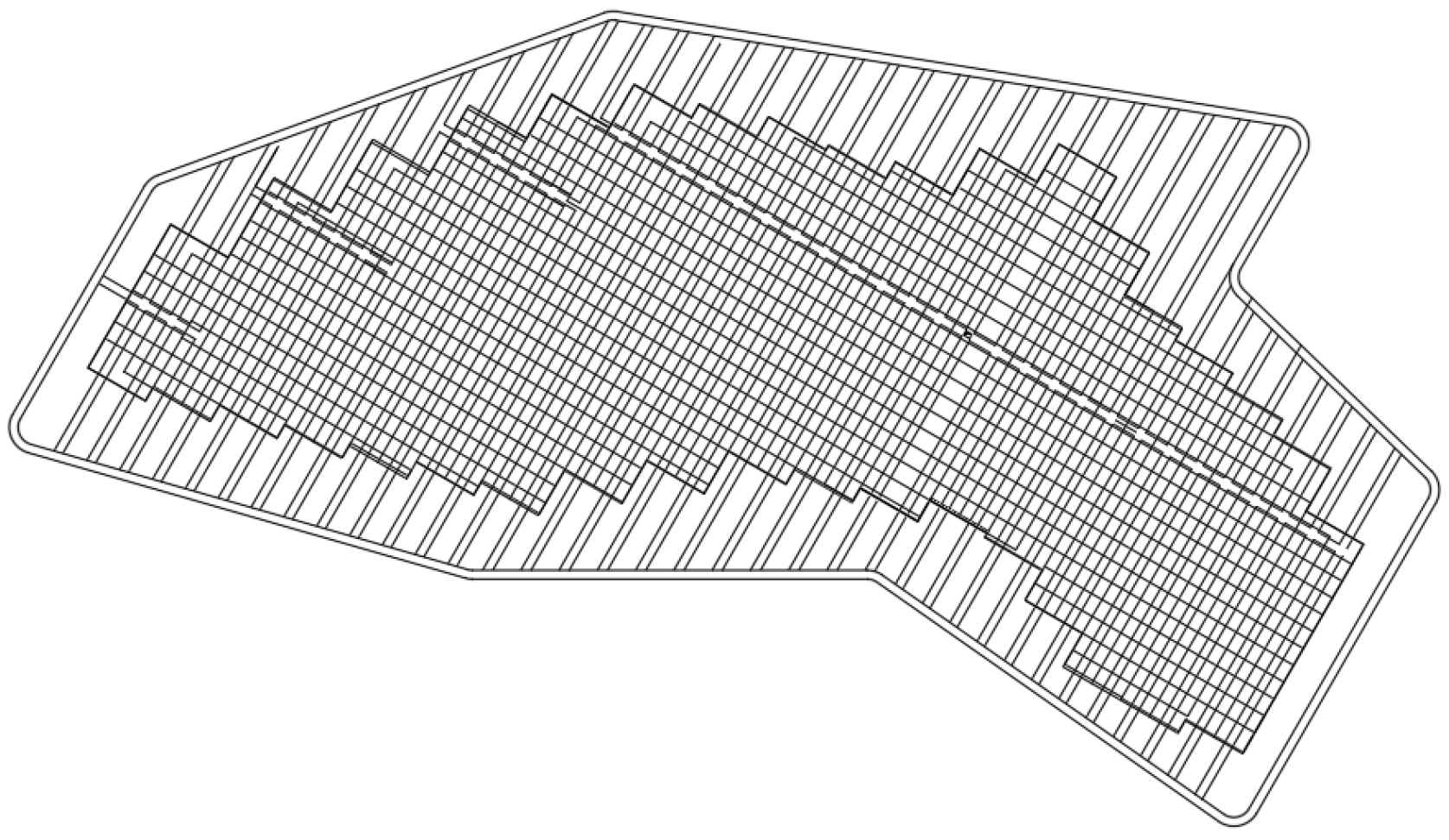
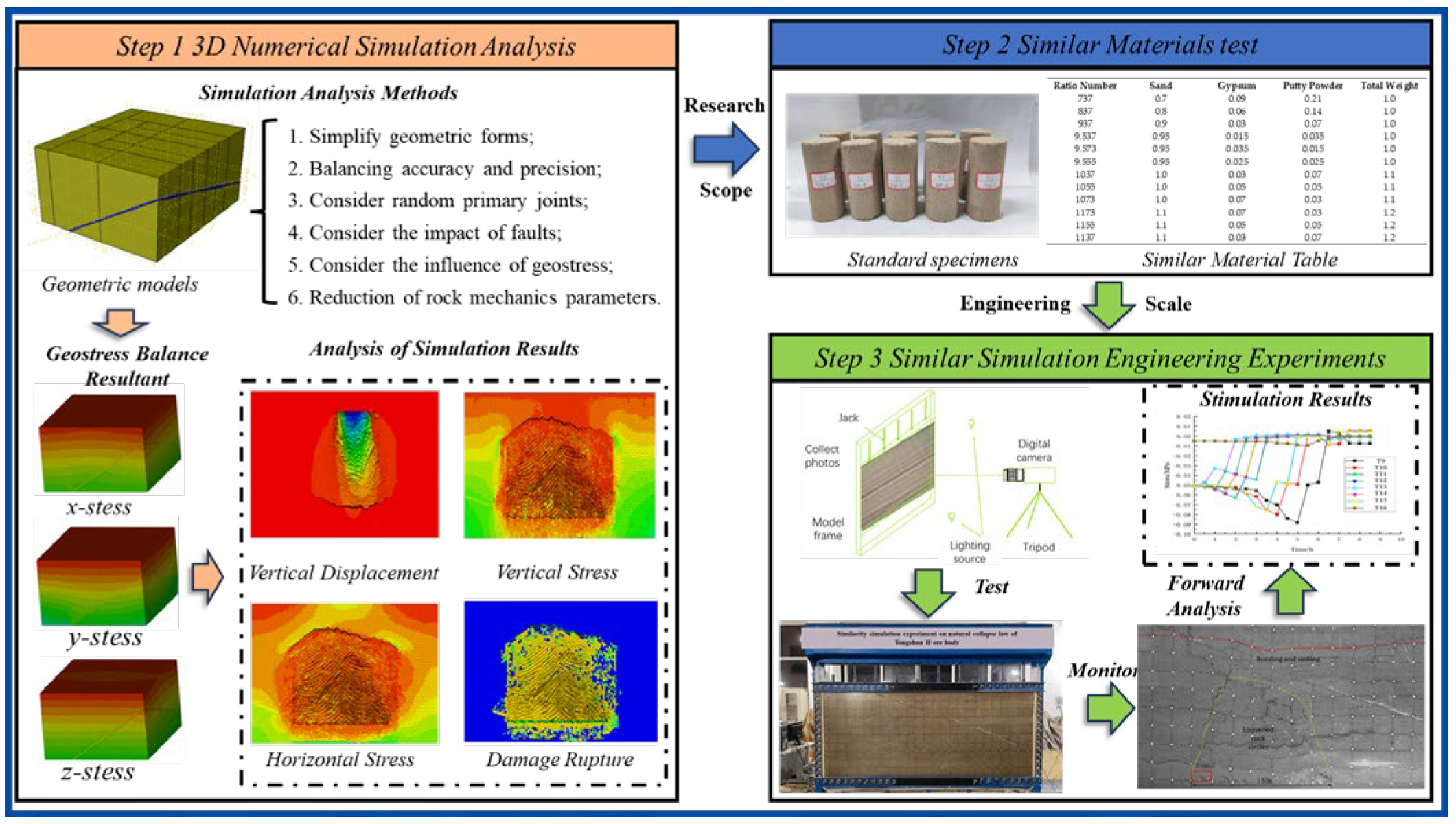
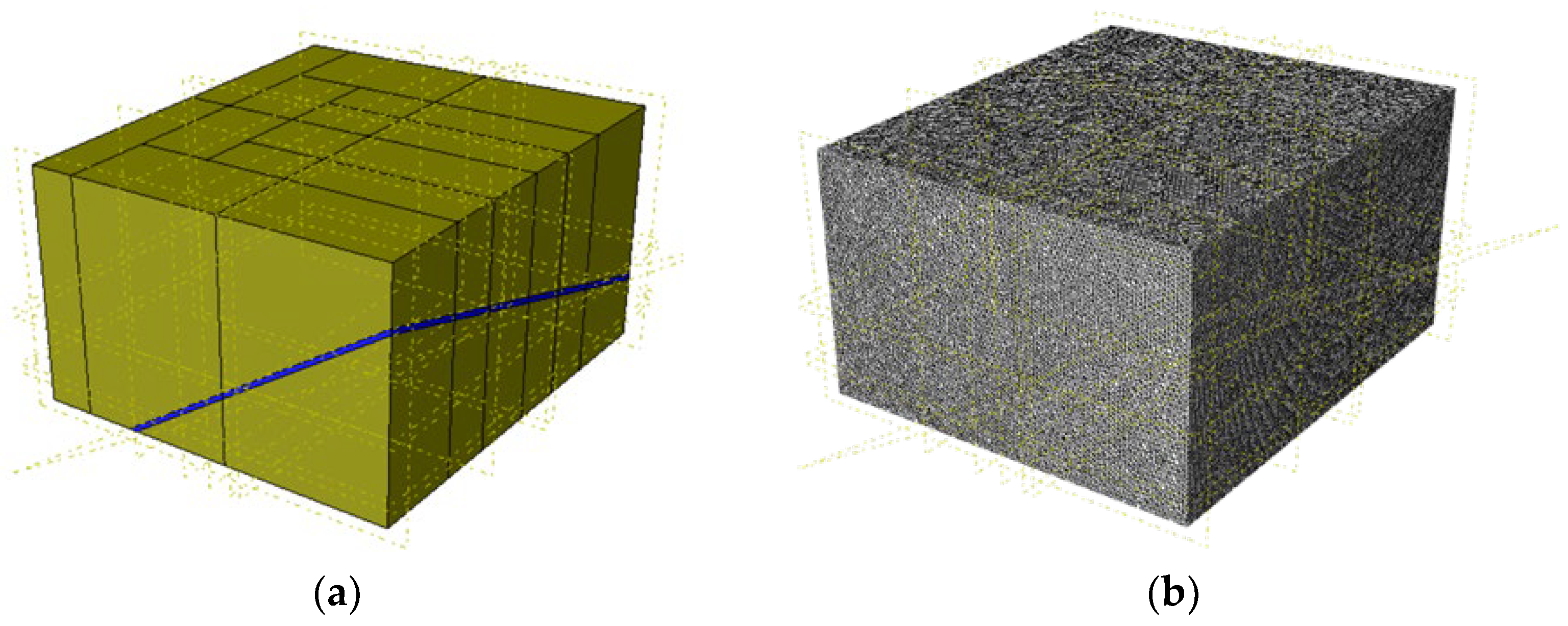
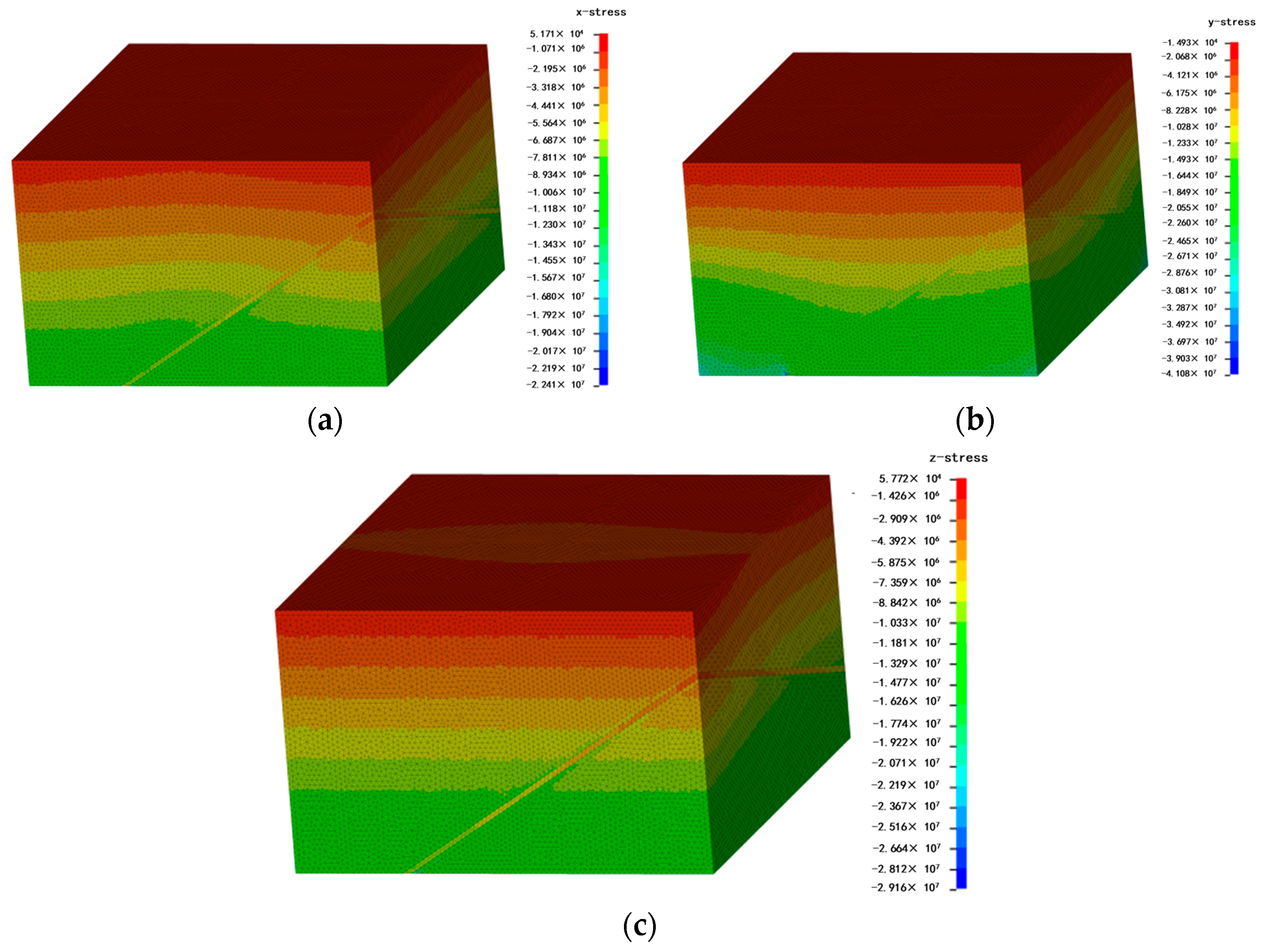
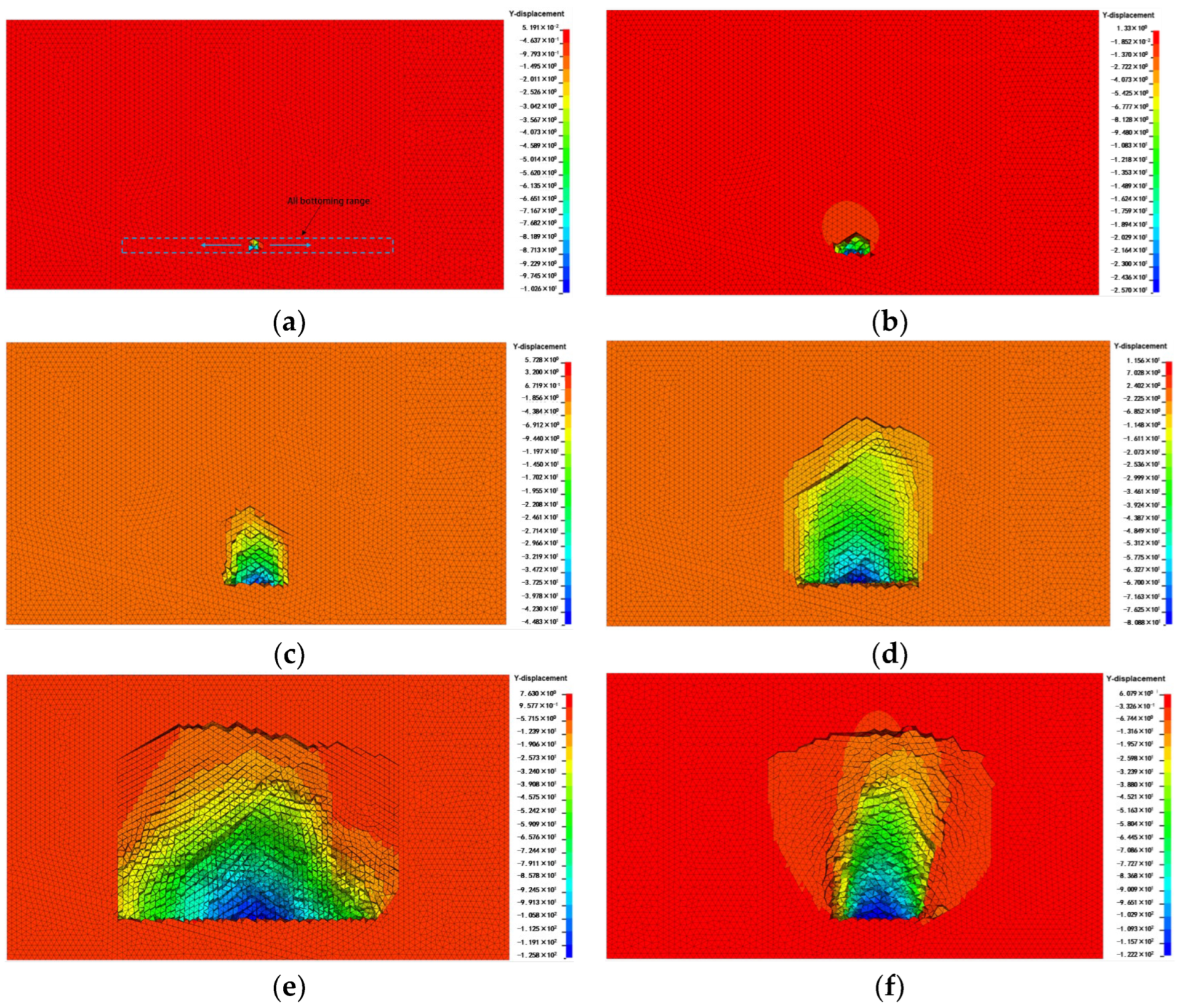
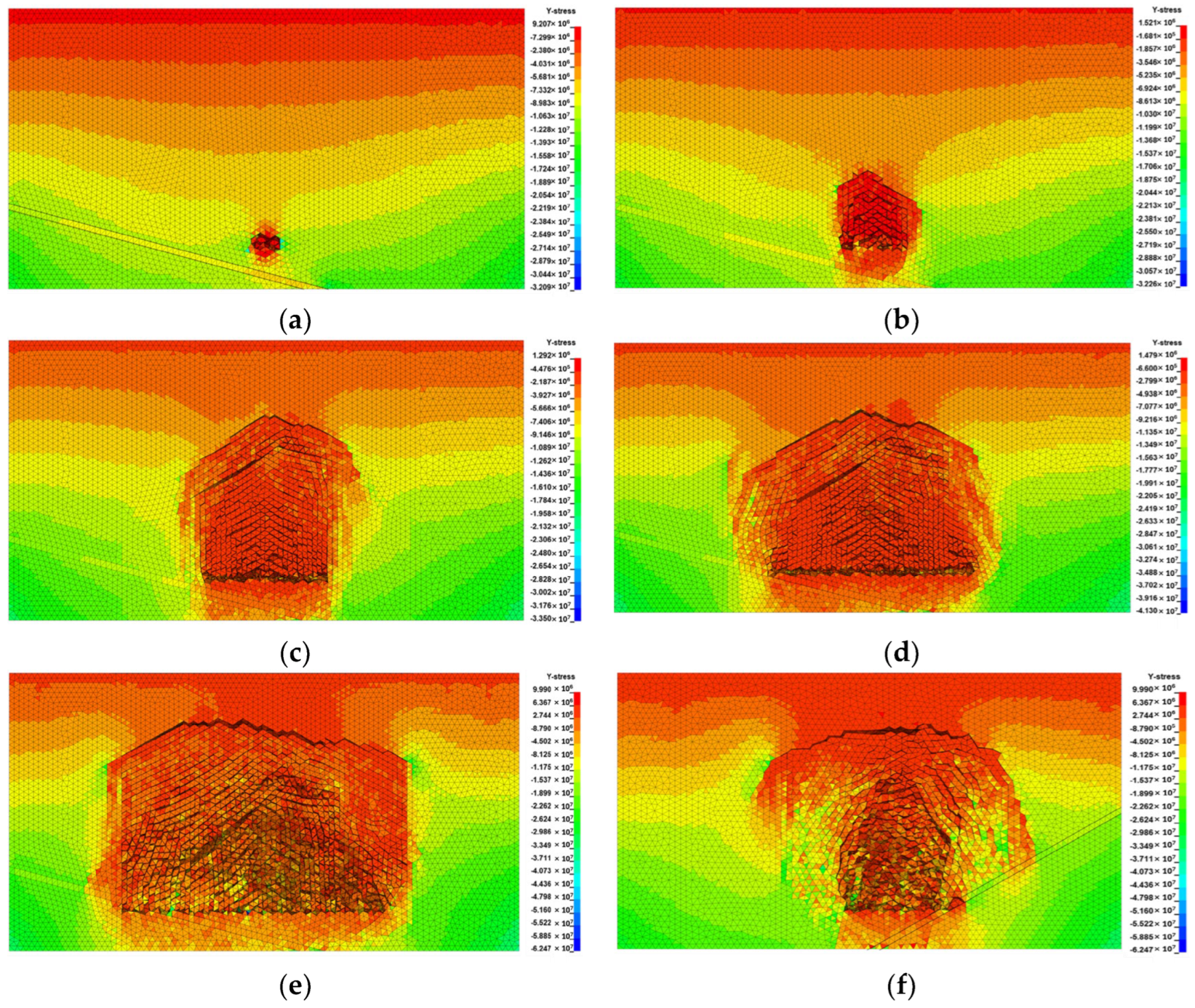
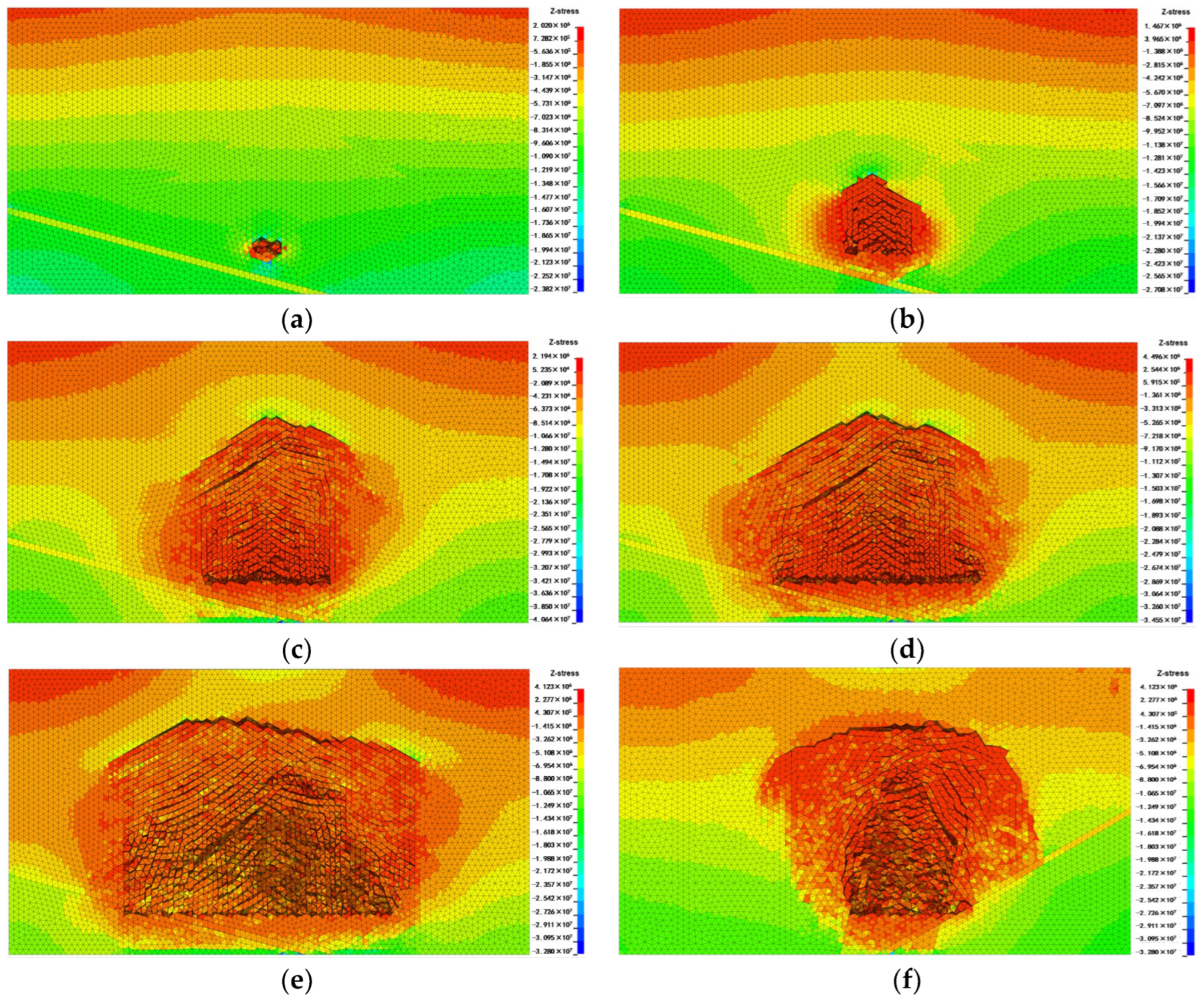

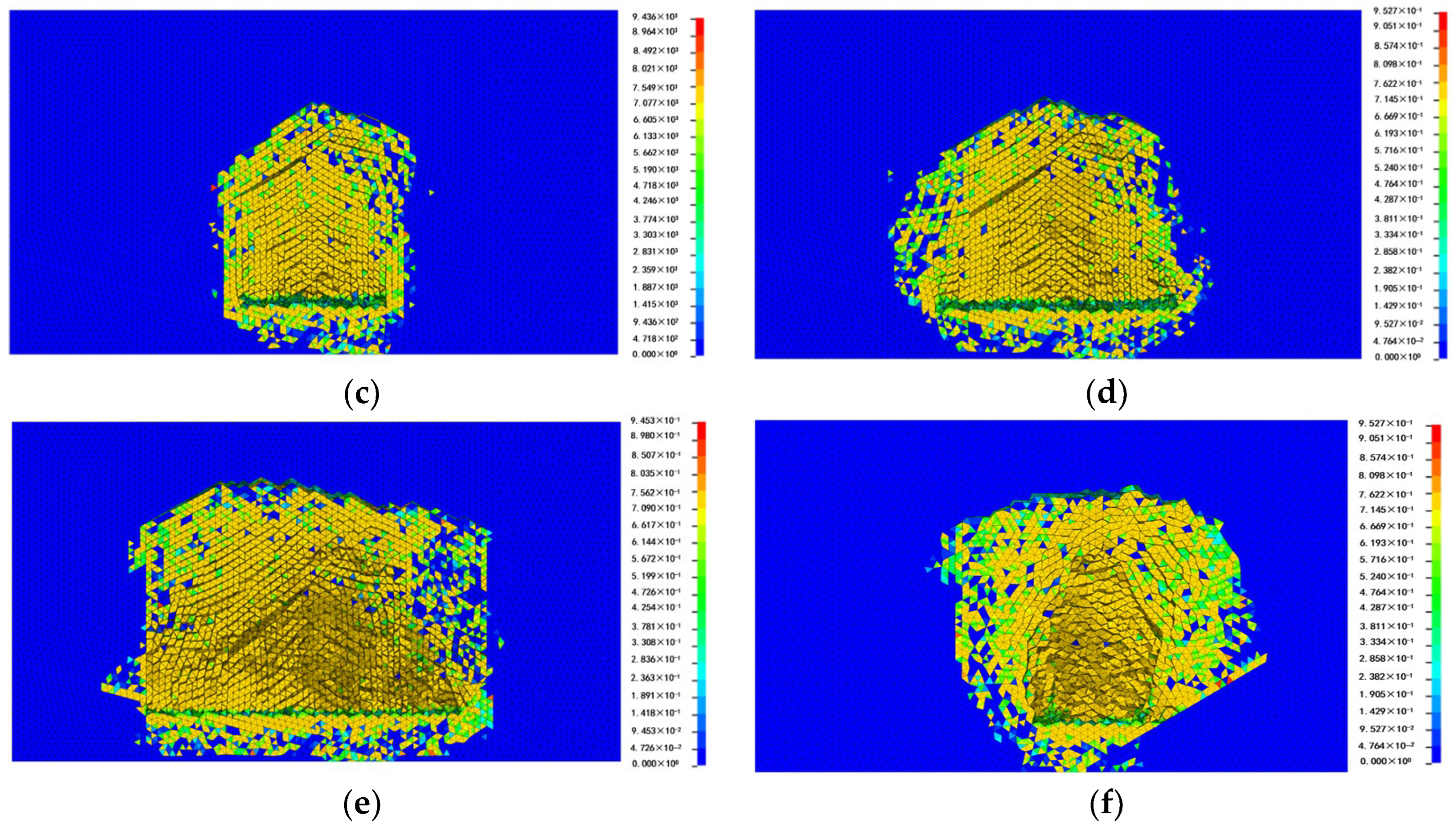

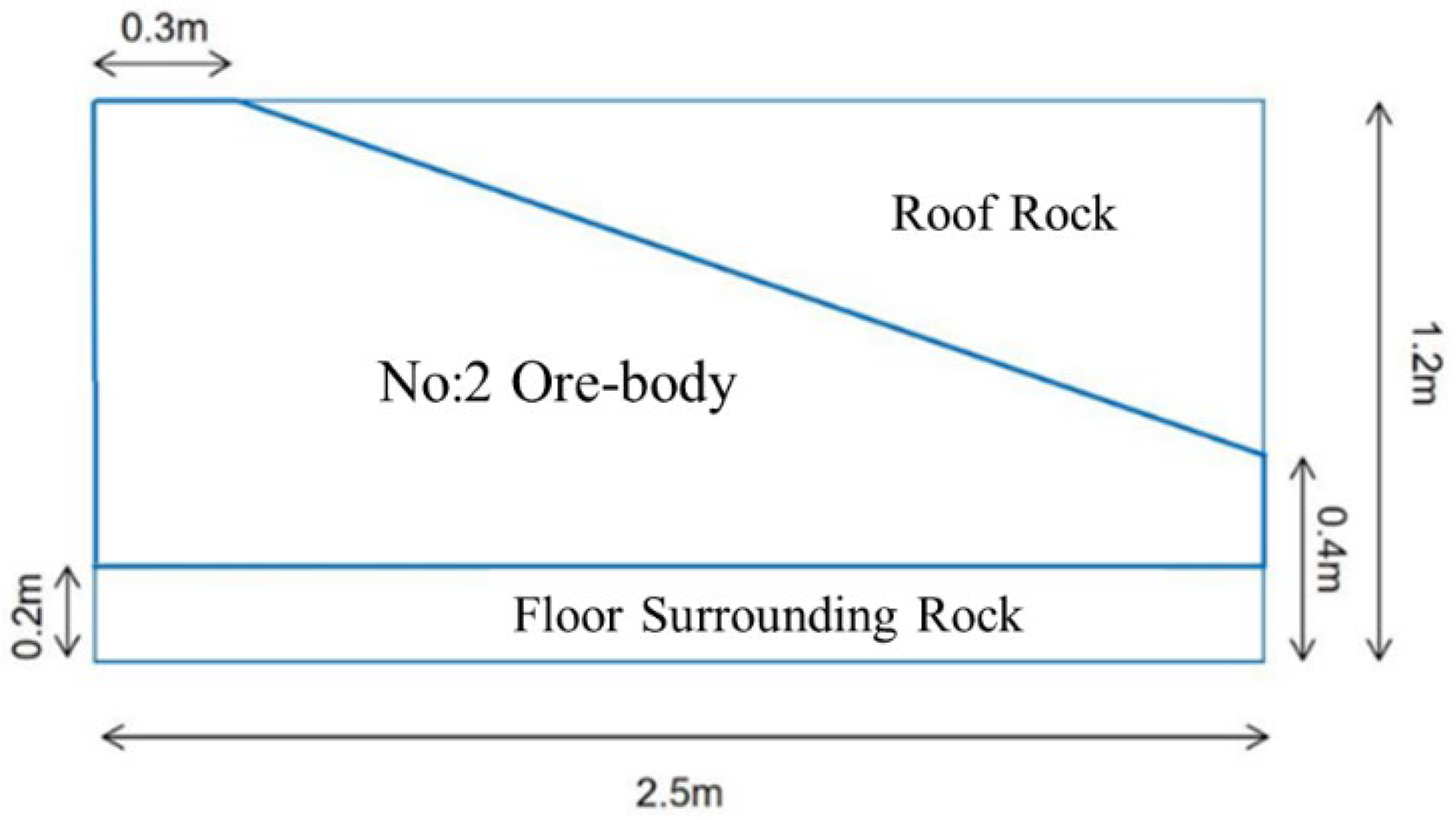
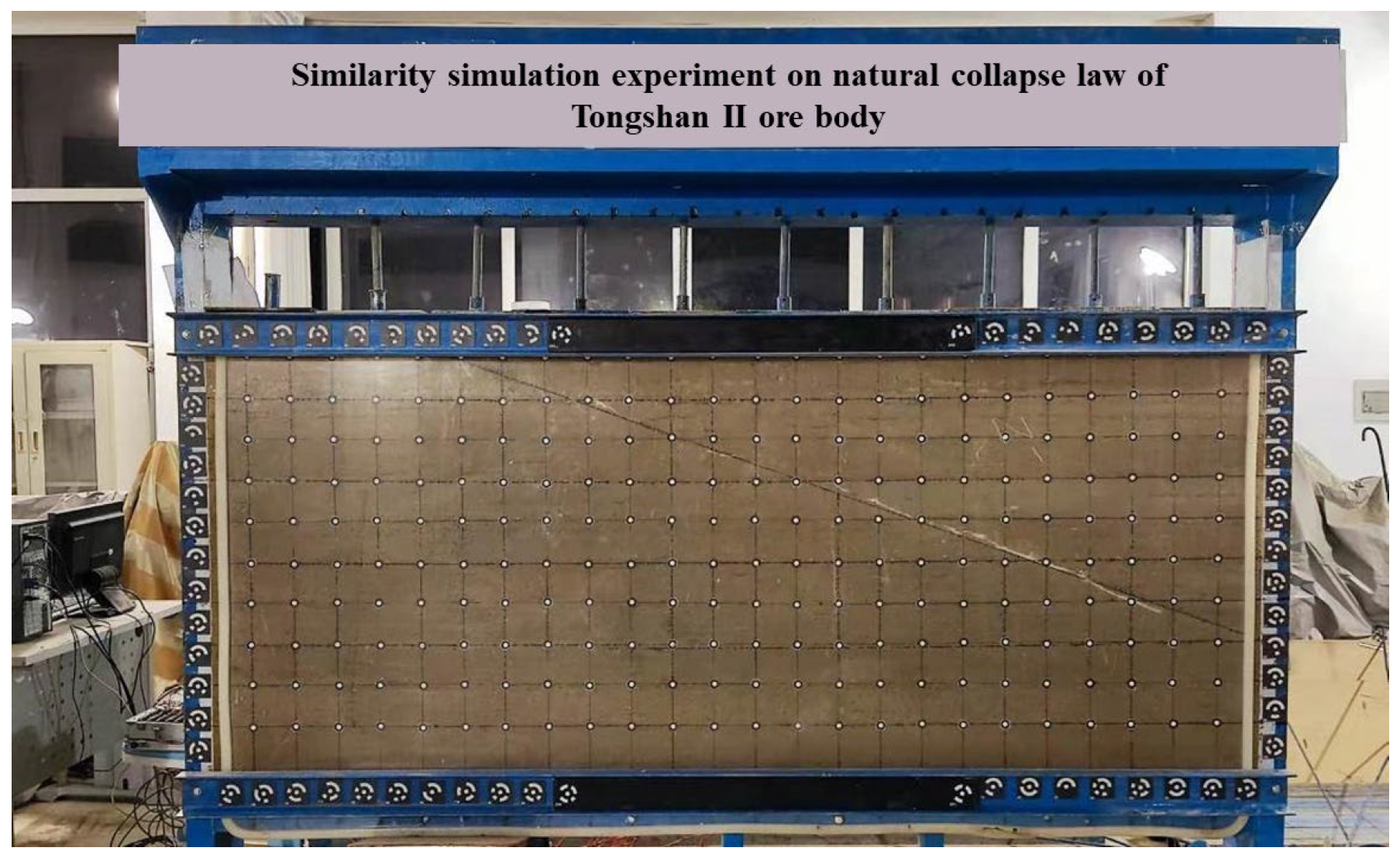
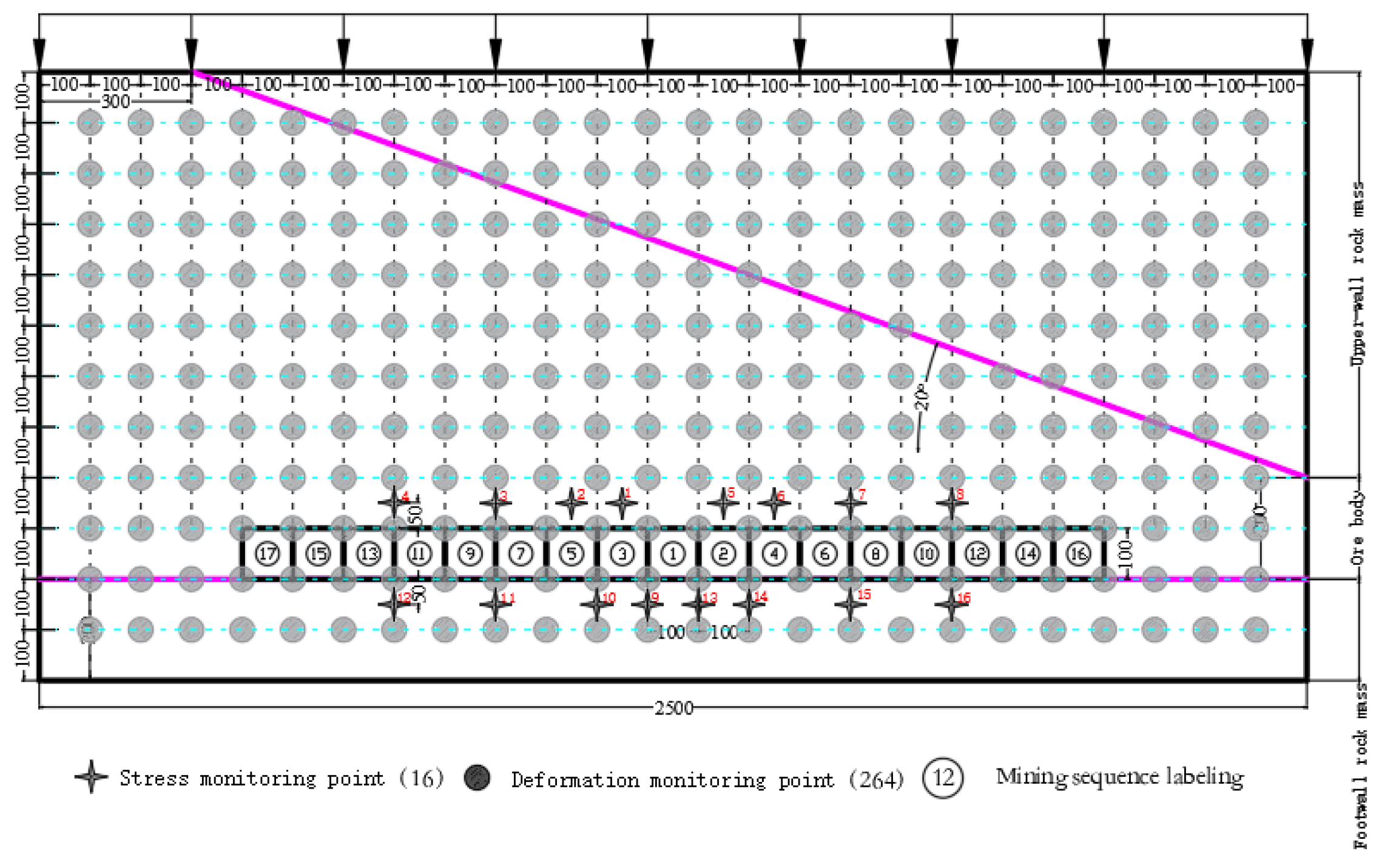
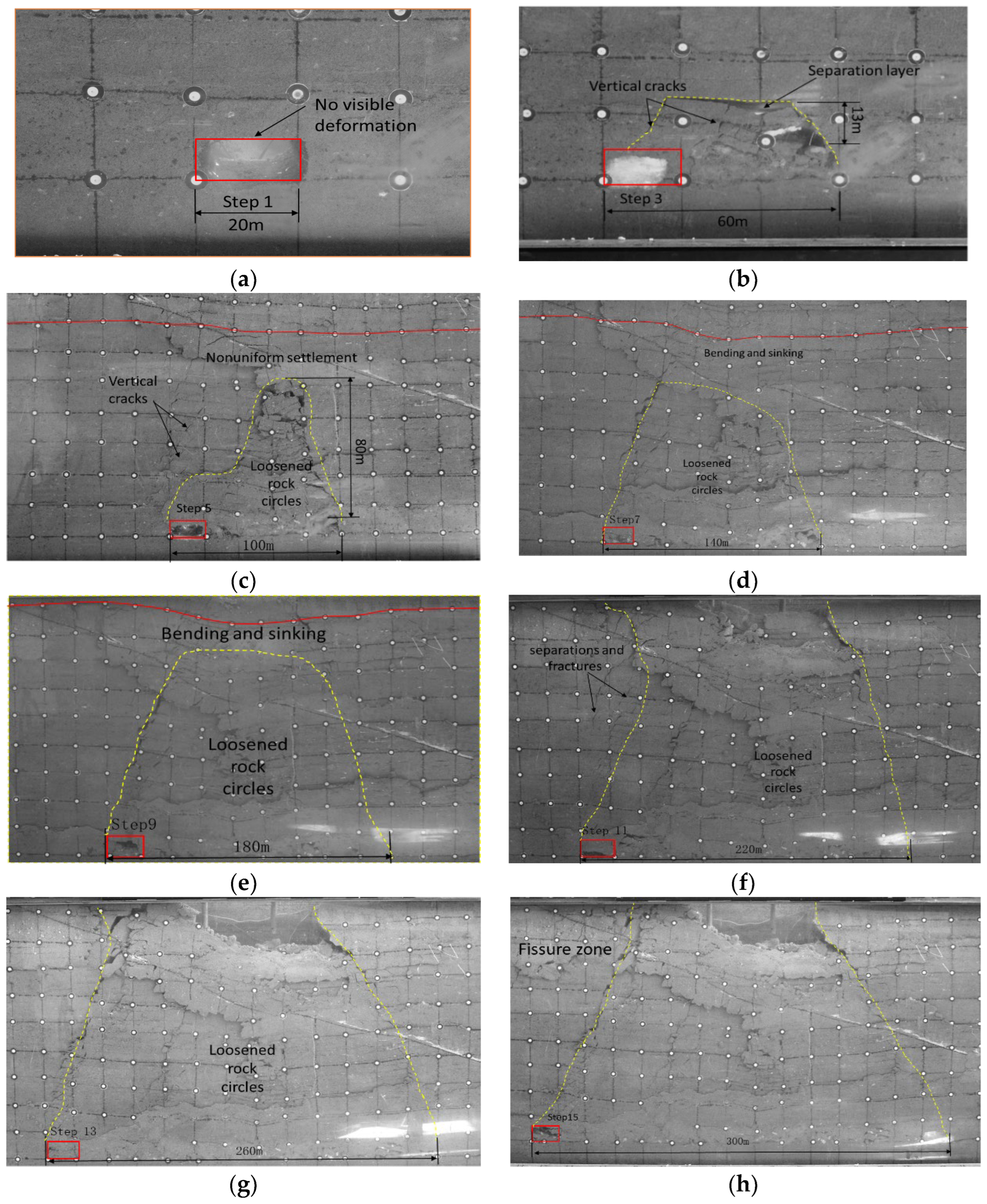
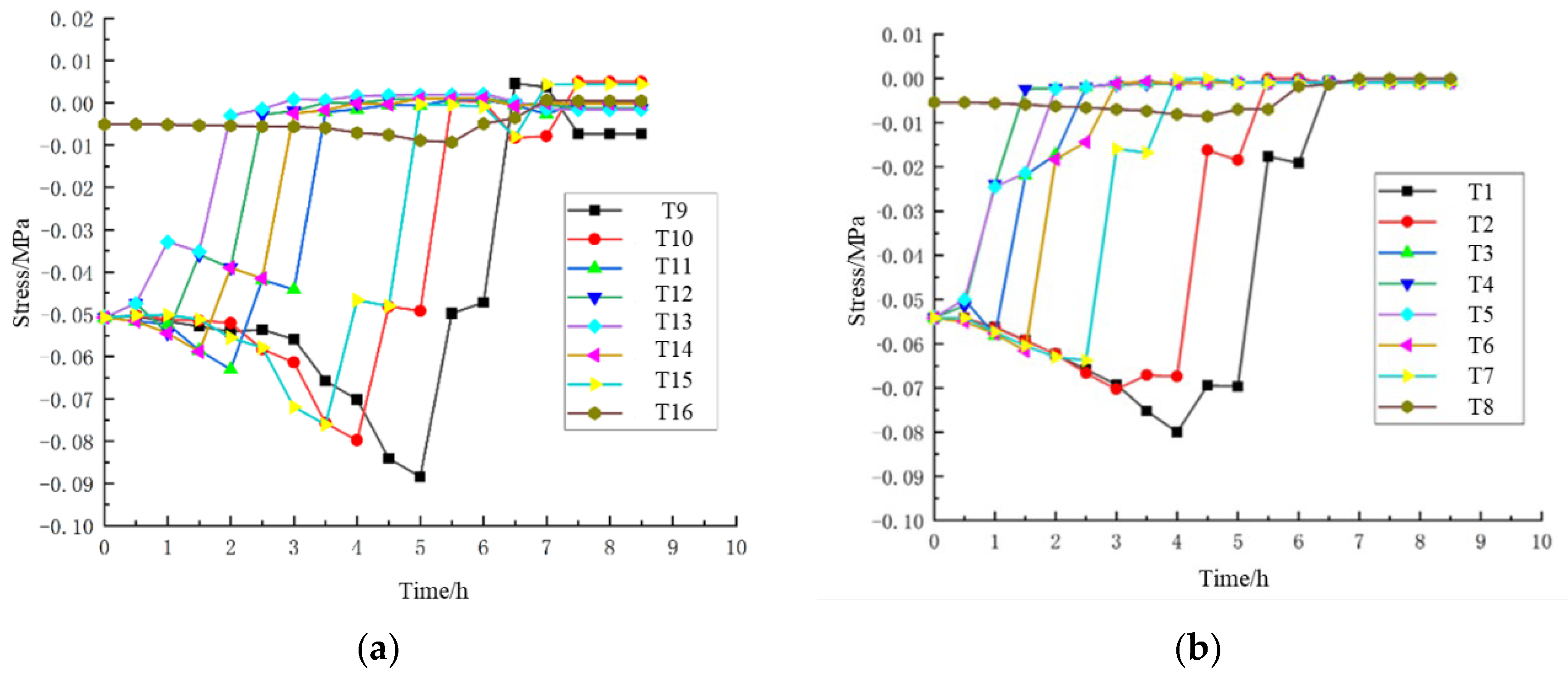

| Parameter | Unit | Rock–Body | Ore Body | Fault | Prefabricated Joints |
|---|---|---|---|---|---|
| Density | Kg/m3 | 2765 | 2780 | 2770 | – |
| Modulus of deformation | GPa | 15.77 | 16.15 | 0.73 | – |
| Poisson’s ratio | – | 0.26 | 0.28 | 0.31 | – |
| Tensile strength | MPa | 0.26 | 0.34 | 0.04 | 0.1 |
| Cohesion | MPa | 5.07 | 5.22 | 0.28 | 0.75 |
| Angle of internal friction | ° | 39.26 | 39.07 | 27.65 | 29.24 |
| Type I fracture energy | J/m2 | 144 | 144 | 50 | 32 |
| Type II fracture energy | J/m2 | 300 | 300 | 150 | 90 |
| Normal contact stiffness | GPa | 71.31 | 53.42 | 8.0 | – |
| Tangential contact stiffness | MN/m | 7130 | 5342 | 800 | – |
| Contact friction coefficient | – | 0.73 | 0.62 | 0.5 | – |
| Normal stiffness of nodal unit | GPa | 3600 | 3600 | 400 | 3600 |
| Tangential stiffness of nodal unit | GPa | 3600 | 3600 | 400 | 3600 |
| Ratio Number | Sand | Gypsum | Putty Powder | Total Weight |
|---|---|---|---|---|
| 737 | 0.7 | 0.09 | 0.21 | 1.0 |
| 837 | 0.8 | 0.06 | 0.14 | 1.0 |
| 937 | 0.9 | 0.03 | 0.07 | 1.0 |
| 9.537 | 0.95 | 0.015 | 0.035 | 1.0 |
| 9.573 | 0.95 | 0.035 | 0.015 | 1.0 |
| 9.555 | 0.95 | 0.025 | 0.025 | 1.0 |
| 1037 | 1.0 | 0.03 | 0.07 | 1.1 |
| 1055 | 1.0 | 0.05 | 0.05 | 1.1 |
| 1073 | 1.0 | 0.07 | 0.03 | 1.1 |
| 1173 | 1.1 | 0.07 | 0.03 | 1.2 |
| 1155 | 1.1 | 0.05 | 0.05 | 1.2 |
| 1137 | 1.1 | 0.03 | 0.07 | 1.2 |
| No | Ratio Number | Compressive Strength/MPa | Average Compressive Strength/MPa | No | Ratio Number | Compressive Strength/MPa | Average Compressive Strength/MPa |
|---|---|---|---|---|---|---|---|
| 1 | 737 | 1.7 | 1.42 | 24 | 1037 | 0.44 | 0.31 |
| 2 | 0.96 | 25 | 0.35 | ||||
| 3 | 1.91 | 26 | 0.36 | ||||
| 4 | 1.11 | 27 | 1055 | 0.34 | 0.355 | ||
| 5 | 837 | 0.87 | 1.0725 | 28 | 0.38 | ||
| 6 | 1.68 | 29 | 0.33 | ||||
| 7 | 0.76 | 30 | 0.37 | ||||
| 8 | 0.98 | 31 | 1073 | 0.38 | 0.365 | ||
| 9 | 937 | 0.52 | 0.515 | 32 | 0.33 | ||
| 10 | 0.42 | 33 | 0.37 | ||||
| 11 | 0.59 | 34 | 0.38 | ||||
| 12 | 0.53 | 35 | 1173 | 0.36 | 0.3075 | ||
| 13 | 9.537 | 0.37 | 0.2775 | 36 | 0.38 | ||
| 14 | 0.24 | 37 | 0.24 | ||||
| 15 | 0.29 | 38 | 0.25 | ||||
| 16 | 9.573 | 0.28 | 0.3075 | 39 | 1155 | 0.14 | 0.1575 |
| 17 | 0.3 | 40 | 0.14 | ||||
| 18 | 0.28 | 41 | 0.18 | ||||
| 19 | 9.555 | 0.3 | 0.3 | 42 | 0.17 | ||
| 20 | 0.28 | 43 | 1137 | 0.13 | 0.145 | ||
| 21 | 0.31 | 44 | 0.14 | ||||
| 22 | 0.31 | 45 | 0.18 | ||||
| 23 | 1037 | 0.45 | 46 | 0.13 |
Disclaimer/Publisher’s Note: The statements, opinions and data contained in all publications are solely those of the individual author(s) and contributor(s) and not of MDPI and/or the editor(s). MDPI and/or the editor(s) disclaim responsibility for any injury to people or property resulting from any ideas, methods, instructions or products referred to in the content. |
© 2024 by the authors. Licensee MDPI, Basel, Switzerland. This article is an open access article distributed under the terms and conditions of the Creative Commons Attribution (CC BY) license (https://creativecommons.org/licenses/by/4.0/).
Share and Cite
Qin, X.; Yang, X.; Liang, Z.; Cao, H.; Xu, L. Study on the Effect of the Undercut Area on the Movement Law of Overburden Rock Layers in the Block Caving Method. Appl. Sci. 2024, 14, 4704. https://doi.org/10.3390/app14114704
Qin X, Yang X, Liang Z, Cao H, Xu L. Study on the Effect of the Undercut Area on the Movement Law of Overburden Rock Layers in the Block Caving Method. Applied Sciences. 2024; 14(11):4704. https://doi.org/10.3390/app14114704
Chicago/Turabian StyleQin, Xiushan, Xiaocong Yang, Zhonghao Liang, Hui Cao, and Liu Xu. 2024. "Study on the Effect of the Undercut Area on the Movement Law of Overburden Rock Layers in the Block Caving Method" Applied Sciences 14, no. 11: 4704. https://doi.org/10.3390/app14114704
APA StyleQin, X., Yang, X., Liang, Z., Cao, H., & Xu, L. (2024). Study on the Effect of the Undercut Area on the Movement Law of Overburden Rock Layers in the Block Caving Method. Applied Sciences, 14(11), 4704. https://doi.org/10.3390/app14114704






